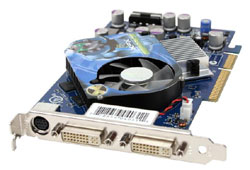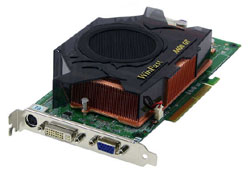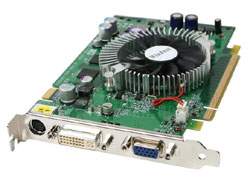Buyer's Guide - Mid-Range, January 2005
by Jarred Walton on January 21, 2005 11:09 AM EST- Posted in
- Guides
Video Card Recommendations
The ups and downs of SLI are becoming more apparent as time passes. There have been some reports of general flakiness with SLI setups, particularly if you're using the DVI connection of your graphics card. Applications ("games" in reality, as we're not aware of any optimizations for non-gaming programs) require hard-coded driver support in order to use SLI; if NVIDIA hasn't yet profiled a game, SLI systems will render using only one video card. You can still purchase an SLI motherboard, but our recommendations here are concerned with Mid-Range price/performance, and SLI - and particularly high-performance PCIe cards - does not fit well in this price segment. Remember that for Intel, we give the PCIe configuration a full recommendation, but for AMD, we're still hesitant. We'll start with the AGP side of things.
AGP Recommendation
XFX 6600GT AGP 128MB GDDR3Price: $209 Shipped
The selection of 6600GT cards in AGP format is beginning to improve, as is the price. While it may not be the cheapest option available, we like the features that the XFX 6600GT 128MB [RTPE: PVT43AND] brings to the table. Specifically, the dual DVI output is a great inclusion for the future. If you don't have an LCD yet, you can use an adapter to run a standard VGA connection, but for LCD users, you will definitely want to get a DVI capable display and graphics card. The ability to run dual LCD displays - and if you're going to use two displays, we strongly recommend LCDs due to their space saving characteristics - would thus require two DVI ports, or else you would have to run with the lower quality VGA connection on one display. Is it absolutely necessary? No, but for an extra $10, we prefer the capability, just in case. An added benefit is that the XFX is clocked at 500 MHz on both the core and the memory; the official specification for the AGP 6600GT cards has the RAM clocked at 450 MHz, unlike the PCIe models. Granted, with overclocking, you could probably push any of the cards to 500 MHz and even further, but for an out-of-box experience, we like the manufacturer-approved "overclock".
There is one noteable drawback to the XFX card, unfortunately. It is relatively loud. We're not talking FX 5800 Ultra levels, by any means, but it is definitely audible. If you want something quieter and are willing to lose the dual-DVI and factory overclock options, MSI makes a very good 6600GT card that is near-silent in comparison. BFG also makes a good card that includes even more factory overclocking than the XFX, but it costs almost as much as a 6800 card, so unless the price drops to match the other 6600GT cards, it is difficult to recommend.
AGP Alternative
Leadtek A400GT TDH 256MB GDDR3Price: $377 Shipped
If you're truly interested in performance without breaking the bank, the best Mid-Range option to get you there remains with the AGP GeForce 6800GT [RTPE: A400 GT TDH]. The Leadtek cards also include a large, two-slot copper heatsink, which should help to keep the card cool. If you like our above recommendation to get a dual-DVI card where possible, you'll have to spend $30 more to get an XFX card. Lately, XFX has started to make a point of offering dual DVI output on all their cards. They do have some 6800GT cards with a VGA/DVI output for less money, but nearly all of their new cards are now dual-DVI.
For an in-between alternative, the 12 pipeline 6800 cards are also viable. They're not tremendously faster than the 6600GT - in fact, in terms of pixel processing power, it's basically a tie between the two chips - but they do have a 256-bit memory interface that can help out quite a bit in certain applications. For a price that's pretty much right in line with the performance increase/decrease relative to the 6600GT and the 6800GT, the BFG 6800 OC [RTPE: BFGR6800] would be our pick. Depending on your location, it can be had for as little as $259.
PCIe Recommendation
Leadtek Winfast PX6600GT TDH PCIe 128MBPrice: $190 Shipped
If you want to get a PCI Express system, the only reasonably mid-range option is the 6600GT. The 6800 PCIe cards carry a large price premium at present, so they remain high-end options. We recommend that anyone who is looking at the 6600GT cards should read our 6600GT roundup. One of the key stumbling blocks for a lot of the cards was a poorly mounted HSF, which could cause problems if you swap hardware a lot or move your computer around much. Basically, the advice for most of the 6600GT cards is "handle with care". Our recommendation goes to the Leadtek 6600GT [RTPE: PX6600GT TDH], the Gold Editor's Choice card from the roundup. The card runs cool and quiet, overclocking is decent - about in line with most of the other cards - and the HSF is mounted securely. Again, dual-DVI is an option with the XFX model [RTPE: PVT43GND], which was our runner-up Silver Editor's Choice. It wasn't without issues, noise being one of them, but there aren't many options that we're comfortable recommending at this point which have dual-DVI.
Despite all of our talk about SLI not offering much, it is an option some will like. It doesn't save you much over the long term relative to AGP, but it's better than nothing. We're really looking forward to the actual retail availability of ATI's X800 and X800XL cards, which are supposed to target prices of $199 and $299 respectively. It may take two months for them to actually reach that price, if the trends of the past few months continue, but they do bring some needed competition to the low- to mid-range PCIe segment. Serious ATI fans who are looking for good value really have only one option right now, the X700 Pro [RTPE: X700 Pro]. While the 256 MB of RAM might seem attractive, it really doesn't help that much and we would prefer a faster core and RAM rather than more RAM running at slower speeds. The X700 XT, unfortunately, has been removed from ATI's lineup, so you'll have to wait for the X800. For top PCIe performance, the 6800GT PCIe card with an eye towards SLI would make sense, but the $475 price point per card is $100 more than its AGP counterpart and well into the high-end segment.













46 Comments
View All Comments
Rocket321 - Saturday, January 22, 2005 - link
Could someone explain what has changed between the NEC 3520A and 3500A. I checked the Anandtech Fall 16x roundup and it has the 3500A listed as DVD-R 16x.Dranzerk - Saturday, January 22, 2005 - link
Mmm, i bought my 930sb from Newegg about 6 months ago, guess they ran out fast. Oh well. :(N3cr0 - Saturday, January 22, 2005 - link
Well, I think I may go with the system described with the ASUS board but a 3000+ processor to save some cash. As it stands right now, anything is an upgrade from my Celeron 1.2 system. The XFX 6600GT is also available for dramatically less then the Leadtek (40-50$ less) 6600GT, so I'm going to be going with that also.Zebo - Saturday, January 22, 2005 - link
"The Diamond Pro 930sb Mitsubishi monitor is also a excellent CRT choice for 19inch."Too bad no one sells it:(
Zebo - Saturday, January 22, 2005 - link
KILLER CHOICES!!!'Another good mobo is epox 9NDA3J... it's $45 less than MSI..same clocks many say better with new bios. I post at 330 HTT now vs 315 before.. My mem OCs much more too..
JarredWalton - Friday, January 21, 2005 - link
20 - NEC and Mitsubishi "merged" on the monitor segment. The NEC FE991SB is almost the same monitor as the Diamond Pro 930SB. The 930SB did have a few advantages, like a 110 KHz hoizontal scan rate and a slightly higher max resolution, and perhaps a few cosmetic differences.Unfortunately, the 930SB is no longer available online as far as I can tell (and it did cost a bit more). That's why it's no longer in the Guide. If you can find one, it's still a great monitor, although I wouldn't pay much more than $285 for it.
Dranzerk - Friday, January 21, 2005 - link
The Diamond Pro 930sb Mitsubishi monitor is also a excellent CRT choice for 19inch. Very nice monitor, gets great reviews, and cheap to boot.I beleive it used to be Anandtech buyers guide..maybe another type? check it out
JarredWalton - Friday, January 21, 2005 - link
#17 - certainly something to think about, although there are so many possible causes that a lot of people don't tend to list in forums. For example, are they overclocking? What sort of PSU are they running (as a 300GB three platter hard drive inherently uses more power than an 80GB one platter drive)?Most of the posts seem to be related to having RAID issues. I won't even get into the subject of RAID, but having two of those drives running is going to further increase the power demands. What sort of GPU do they have, CPU, etc.? People looking at running two or even three $200 drives are probably putting in other high-end hardware as well, and a 480W PSU - even a quality Antec, Enermax, etc. - may not be able to handle the power demands.
Anyway, the Maxtor is merely listed as an alternative. Plenty of people are using them without any problems, but they're also not using two of them in most instances.
PrinceGaz - Friday, January 21, 2005 - link
Those are a truly excellent set of recommendations for systems in that price-range, Jarred. Compared with your first few guides which I considered to have quite a few poor choices; I read through this guide from start to finish, and without exception either agreed with your choices or would have went with something so close it made no real difference.I'm very close to building an nForce4/A64 box and regularly looking at my options (the only thing I'm waiting for now is the E0 A64 revision), and at some points what you wrote was so close to my own thoughts that I almost felt as if I was reading something I'd written myself!
The only bone I'd pick is with SLI. I'll probably get an SLI board, but not for the SLI capability but because they tend to have more PCIe sockets generally if you run in non-SLI mode and treat the second x16 as a x1. I'll never buy another legacy PCI card, so the two PCI cards I already have are all I'd ever want to put in a new PCIe system, therefore the more PCIe sockets it has the better. The MSI Neo4 SLI board fails miserably in that respect as it has no PCIe slots at all apart from the two x16 slots, so at most you can put a single PCIe x1 card in. I hope MSI gets suitably slated in the forthcoming review because of that.
mad nebraskan - Friday, January 21, 2005 - link
With all due respect, the recommendation of the Maxtor 250GB drive in combination with the MSI Neo2 MB might not be a good one. I helped a friend who had serious issues trying to get a RAID 0+1 to work using this board. We finally gave up and bought Raptors. A quick search of the net found this forum:http://forum.msi.com.tw/thread.php?threadid=63105&...
Now, the problem might be fixed with the latest BIOS, but I don't think it it.
http://forums.pcper.com/showthread.php?t=368404
Just some thoughts from a guy who banged his head against this particular problem too many times.